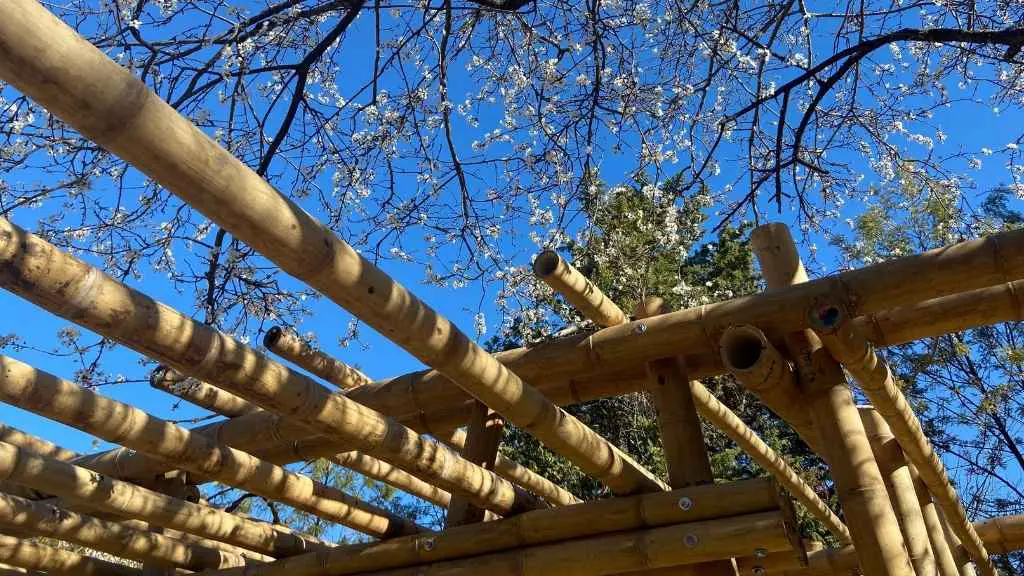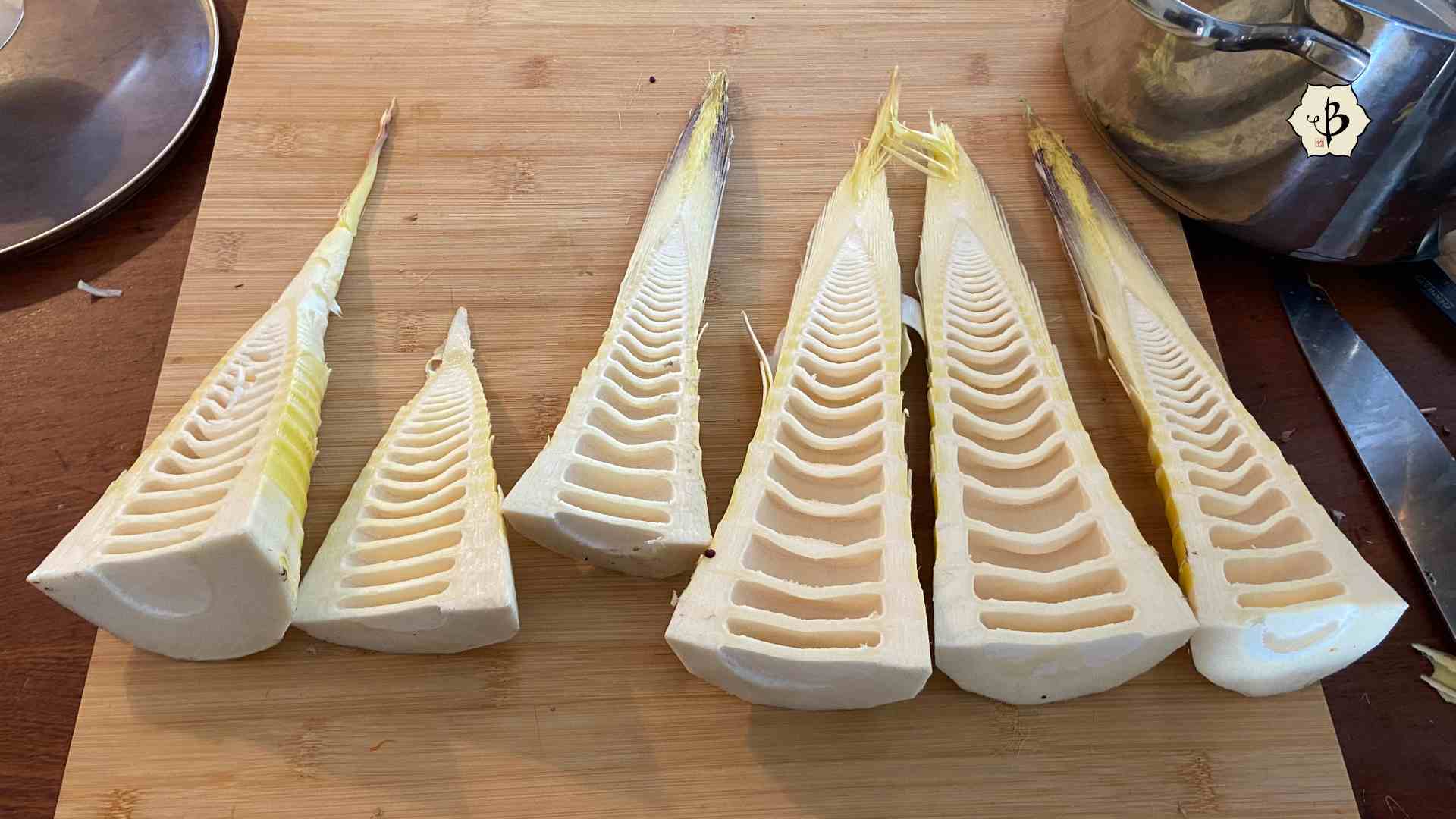Bamboo is a remarkable plant that is both attractive and useful. I like working and crafting with it because it’s strong and lightweight. And if you’ve ever sawed through a bamboo pole to make something as simple as a garden stake or a curtain rod, you probably felt the same way. And you might have also wondered: why is bamboo hollow?
Bamboo is rock hard and as strong as lumber, but usually the poles are hollow on the inside. That’s because, despite its strength, bamboo is actually a grass and not a tree. One of the defining characteristics of grasses is that they have hollow stems, also known as culms. This allows bamboo and other grasses to grow quickly and remain flexible. They can get tall without getting overly heavy. But you may be surprised to know that some varieties of bamboo actually have solid, or nearly solid culms.
NOTE: This article first appeared in July 2020, most recently updated in June 2024.

The biology of bamboo and other grasses
According to current classification, there are 91 different genera of bamboo, and more than 1000 unique species, plus a whole host of sub-species. And all of that bamboo belongs in the grass family, Poaceae. Whether they are annual grasses like rice and corn, or perennial grasses like pampas or bamboo, all grasses have hollow stems.
The accurate botanical name for the stem of grass is a culm, and the culms grow in what look like segments. Nodes, or “knuckles”, appear along the culm, at which points the hollow stems are closed off. This accounts for the separate sections you see in a bamboo pole. And for this reason, it’s extremely easy to make something like a bamboo cup or a bamboo vase, simply relying on the closure at the node.
Now perhaps you are wondering about the grass in your front yard which seems to grow in flat blades rather than hollow stems. These kinds of grass are not an exception to the rule. It’s just that they have less conspicuous stems and more prominent leaves. Just like bamboo and any other grass, the sod growing in a well manicured lawn has flat leaves. But it also has hollow stems.
Bamboo is unusual for the size of its culms which are hard, woody and often 2 or 3 inches thick. Many types of timber bamboo have culms 4 or 5 inches thick. Some species, like Dendrocalamus sinicus from Southeast Asia, can develop culms that are more than one foot in diameter. And the stems of timber bamboo can grow as much as 100 feet tall. At this size, these giant bamboos look more like trees, but they are still a grass.
As with all grasses, the leaves emerge from culm sheaths that grow out of the nodes on alternating sides of the stem. Bamboo is unusual, because in many cases lateral branches also grow out of these nodes. This is another factor that causes bamboo to resemble a tree more than a grass. The configuration of the branches on a bamboo plant is one of the features that botanists use to classify bamboo into different genera.
Some grass is more noteworthy for its leaves and culms, and other grasses have distinctive flowers. Wheat, rice and corn are all annual grasses whose flowers produce edible, nutritious grains. Bamboo flowers are less conspicuous and bloom on a more irregular basis. Some bamboos are monocarpic grasses, meaning that they only flower once and then die. Others are polycarpic, meaning they can flower multiple times in the course of their life. The fresh shoots of many bamboo species are edible, but the flowers generally are not.
The advantages of hollow stems
The hollow stem structure of grasses provides certain advantages that could explain how this trait evolved. Because the culms are hollow, grasses like bamboo can grow much faster (and sometimes taller) than solid-stemmed plants and trees. It takes far more energy for a plant to produce the biomass of a solid stem. In grasses, the biomass can be greatly elongated, because the plant is only producing a thin tube.
Many grazing animals feed on grasses, so it’s necessary for grasses to replenish their culms and leaves quickly. This is one possible explanation, although it doesn’t really apply to bamboo. Panda bears are the only animals that feed on bamboo. Another explanation could be that bamboo needs to penetrate the lower forest canopies in order to reach the sunlight. Over the course of evolution, the grass adapted to do this quickly.
Hollow stems also provide an unusual combination of lightweight and structural strength. In other words, they have a very low weight-to-strength ratio. This allows grasses to prop up their leaves and flowers, while also being able to bend and sway in the breeze. If the same amount of biomass were concentrated in a solid stem, it could not have the same size, strength or stability.

Hollow stems make bamboo useful
We can only speculate on the evolutionary story of bamboo, and how this enormous tribe of grasses came to develop such strength, resilience and variety. Why nature prefers some traits over others is not always clear. But we do know that the natural structure of bamboo makes in an incredibly practical building material.
Sawing through bamboo is so much easier than cutting through a comparably sized piece of solid lumber. That’s because the saw only has to go through the thin wall of the giant grass. The material is also much lighter than solid wood. This makes it easier to harvest and transport. Imagine cutting down a 100-foot tree and dragging it through the forest back to your hut. It would take a whole village! But one or two people could easily do the same with a 100-foot stalk of bamboo.
Once harvested, the hollow poles lend themselves to a variety of building methods. Their tensile strength, light weight and flexibility make bamboo poles unusually versatile. A crafty builder can notch the poles and fit thick and thin pieces together. Poles can be stacked together to build some surprisingly tall structures without collapsing under their own weight. You can also split bamboo poles relatively easily, producing strips of various sizes. These strips can be strong enough to use in construction and thin enough to weave into basketry.
In the end, the hollow structure of bamboo makes it possible to do things that would be unthinkable with solid lumber. And best of all, it only takes a few months for a bamboo culm in a mature grove to grow from sprout to full size. As a grass, it is the most renewable building material known to man.
Bamboo varieties that are not hollow
Any admirer of bamboo will recognize the hollow stems of this remarkable plant. But there are actually a handful of bamboo species that have solid or nearly solid stems. These varieties are exceedingly strong and resistant to cracking, but only slightly heavier and somewhat less flexible than hollow bamboo.
Here’s a listing of some of those solid bamboo species from Asia and South America.
Chusquea
The genus Chusquea is endemic to Latin America, and most varieties have stems which are solid or nearly solid. These are clumping bamboos and many of them are also fairly cold-hardy, two characteristics that make them very desirable for gardeners. The most popular species for ornamental cultivation are probably C. gigantea and C. culeou, both native to Chile. Attractive culms and lush foliage make them nice to look at, and the solid poles are great for crafts and light construction.
C. quila is another interesting species, found mostly in the Valdivian temperate forests of Chile and Argentina, up to altitudes of around 2000 feet. This is a climbing variety with winding, almost vine-like culms, which grow more than 50 feet high.
Craftspeople and furniture makers are especially fond of C. quila as a robust and readily renewable building material. It is also prized for firemaking due to its ability to burn easily, even when fresh. In places that have suffered from deforestation, this prolific bamboo has sometimes reclaimed and dominated barren areas, leaving no space for other native vegetation to gain a foothold.
Dendrocalamus stocksii
A mid-sized, non-thorny, loose-clumping bamboo native to southern India, D. stocksii plays an important part in the local furniture-making industry. Like other species of Dendrocalamus, it is sometimes referred to as an “iron bamboo” for its tremendous strength.
The species is indigenous to the humid tropics and is not widely known outside of Central Western Ghats, in the Kerala state of India. Culms grow up to 2 or 3 inches in diameter and to about 30 feet in height.

Dendrocalamus strictus
Another variety of “iron bamboo”, Dendrocalamus strictus has culms that are often (but not always) solid. Canes of this timber variety get 3 to 5 inches in diameter, reaching 50 to 60 feet tall. It grows in other parts of India, to the north and east, as well as Nepal, Bangladesh, Myanmar and Thailand.
Sometimes called Male bamboo, Solid bamboo or Calcutta bamboo, this species is also important in building and light construction. It is used locally for everything from tents and scaffolding to frames from houses and reinforcement for concrete.
Phyllostachys heteroclada
This species is popularly referred to as solid stem bamboo and sometimes as water bamboo. As the name suggests, the culms grow solid or nearly solid, unlike most varieties of bamboo which are characteristically hollow.
Although the stems are almost solid, the roots and culms do have small air canals which help them survive in very wet soil. As its other common name indicates, this variety does relatively well in wet soil. But no varieties of bamboo can really tolerated saturates soil or grow directly in the water. This is also a very cold tolerant species, hardy down to -5 or 10º F.
A running bamboo with a vigorous growth habit, P. heteroclada makes an ideal candidate for privacy screens, especially in very cold or wet areas. The canes grow up to 15 or 20 feet tall, normally not more than 1 inch in diameter. Some nurseries list it as Phyllostachys purpurata. If you’re looking for a solid bamboo species that you can grow in your own garden, in North America, this will probably be your best choice.

Learn more
If you found this article interesting, please consider sharing it with your friends and joining our mailing list. You might also enjoy some of these related blog posts.
- Bamboo terms and anatomy
- Water bamboo: Does bamboo grow in water?
- 10 Best bamboo varieties for your garden
- Best bamboo varieties for construction
PHOTO CREDIT: Stacks of Asper bamboo poles that are clearly hollow. Photo by Fred Hornaday.

























